-
 Bitcoin
Bitcoin $118300
-0.58% -
 Ethereum
Ethereum $3825
0.11% -
 XRP
XRP $3.137
-0.71% -
 Tether USDt
Tether USDt $0.9999
-0.01% -
 BNB
BNB $803.9
-3.37% -
 Solana
Solana $181.5
-1.94% -
 USDC
USDC $0.9999
0.01% -
 Dogecoin
Dogecoin $0.2238
-2.51% -
 TRON
TRON $0.3358
2.12% -
 Cardano
Cardano $0.7844
-2.16% -
 Hyperliquid
Hyperliquid $43.31
-1.48% -
 Sui
Sui $3.807
-4.04% -
 Stellar
Stellar $0.4203
-1.96% -
 Chainlink
Chainlink $17.79
-3.00% -
 Bitcoin Cash
Bitcoin Cash $567.8
-1.34% -
 Hedera
Hedera $0.2614
-4.30% -
 Avalanche
Avalanche $24.19
-4.46% -
 Litecoin
Litecoin $109.2
-0.74% -
 UNUS SED LEO
UNUS SED LEO $8.969
-0.01% -
 Toncoin
Toncoin $3.404
3.97% -
 Ethena USDe
Ethena USDe $1.001
-0.01% -
 Shiba Inu
Shiba Inu $0.00001307
-3.19% -
 Uniswap
Uniswap $10.33
-1.23% -
 Polkadot
Polkadot $3.884
-4.06% -
 Monero
Monero $312.9
-1.87% -
 Dai
Dai $1.000
0.01% -
 Bitget Token
Bitget Token $4.537
-2.24% -
 Pepe
Pepe $0.00001156
-3.40% -
 Cronos
Cronos $0.1437
-0.89% -
 Aave
Aave $282.8
-2.77%
Low-level red three soldiers + step back on the morning star pattern with shrinking volume
The "low-level red three soldiers" and "step back morning star" patterns, combined with shrinking volume, signal a strong bullish reversal after a downtrend, especially in high-liquidity cryptocurrencies like BTC and ETH.
Jul 29, 2025 at 08:49 pm
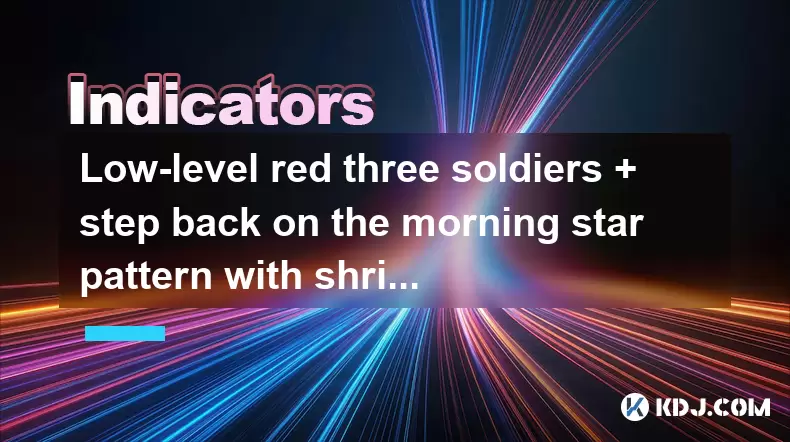
Understanding the Low-Level Red Three Soldiers Pattern
The Low-level red three soldiers pattern is a bullish reversal formation observed in candlestick charting, typically emerging after a prolonged downtrend. This pattern consists of three consecutive green (or white) candles, each opening within the body of the previous candle and closing progressively higher. The significance of this pattern lies in its ability to signal a shift in market sentiment from bearish to bullish, especially when it appears at or near a key support level. Each candle in the sequence should display a strong close near its high, indicating sustained buying pressure. The term "low-level" emphasizes that this pattern forms after a notable decline, increasing the probability of a genuine reversal rather than a temporary bounce.
Important characteristics include:
- Each candle must have a long green body with minimal upper or lower shadows.
- The closing price of each candle should be higher than the prior candle’s close.
- The opening price of candles two and three should occur within the real body of the previous candle.
- Volume trends during the formation can enhance the reliability of the signal.
When volume is shrinking during the downtrend leading into this pattern, it suggests weakening selling pressure, which further supports the potential for a reversal.
Interpreting the Step Back on the Morning Star Pattern
The step back on the morning star is a nuanced variation of the classic morning star pattern, a well-known bullish reversal signal. The traditional morning star consists of three candles: a long red candle, a small-bodied candle (often a doji or spinning top) that gaps down, and a long green candle that gaps up and closes well into the first candle’s body. The "step back" variation modifies this by showing a small-bodied candle that does not necessarily gap down but instead forms a consolidation or pause after a sharp decline.
Key features of this pattern include:
- A long red candle indicating strong bearish momentum.
- A second candle with a small body, reflecting indecision and a potential halt in selling.
- A third long green candle that confirms the reversal by closing above the midpoint of the first candle’s body.
- The "step back" refers to the slight pullback or hesitation before the bullish momentum resumes.
When this pattern appears after a downtrend and aligns with the low-level red three soldiers, it strengthens the bullish case. The shrinking volume during the prior decline suggests exhaustion among sellers, making the reversal more credible.
Volume Analysis: The Role of Shrinking Volume
Volume plays a critical role in validating reversal patterns. Shrinking volume during a downtrend indicates diminishing interest from sellers. As price continues to fall but volume decreases, it suggests that the downward move lacks conviction. This divergence between price and volume often precedes a reversal.
When analyzing the low-level red three soldiers and step back morning star patterns, shrinking volume in the preceding bearish phase increases the likelihood of a sustainable turnaround. Traders should look for:
- A visible decline in average volume bars during the downtrend.
- A slight pickup in volume during the formation of the third green candle in the red three soldiers.
- Confirmation that volume on the final green candle is higher than the previous two, signaling renewed buyer interest.
Using volume indicators such as the On-Balance Volume (OBV) or Volume Oscillator can help visualize this divergence. For example, if price makes a new low but OBV fails to confirm it, this is a bullish divergence.
How to Identify the Combined Pattern on a Cryptocurrency Chart
To spot the combined signal of low-level red three soldiers and step back on the morning star with shrinking volume, follow these steps:
- Open a cryptocurrency trading chart (e.g., Bitcoin/USDT on Binance) using a candlestick view.
- Set the time frame to 4-hour or daily for stronger signals.
- Identify a clear downtrend using trendlines or moving averages (e.g., price below the 50-day and 200-day EMA).
- Look for three consecutive green candles with progressively higher closes after the downtrend.
- Confirm that the second and third candles open within the body of the prior candle.
- Check for a prior small-bodied candle (doji or spinning top) following a long red candle — this is the "step back" element.
- Use the volume indicator below the chart to verify that volume has been declining during the downtrend.
- Ensure that volume increases slightly on the third green candle to confirm buyer participation.
Platforms like TradingView allow you to annotate these patterns using drawing tools. Apply the “Candlestick Pattern” scanner to automatically detect morning star or three white soldiers patterns.
Trading Strategy Based on the Combined Signal
Executing a trade based on this combined pattern requires precise entry, stop-loss, and take-profit levels.
- Entry: Place a buy order at the close of the third green candle or on the opening of the next candle.
- Stop-loss: Set below the low of the entire three-candle pattern or below the lowest point of the recent downtrend.
- Take-profit: Target the nearest resistance level, measured move, or Fibonacci extension (e.g., 1.618x the height of the downtrend).
- Use risk-reward ratios of at least 1:2.
For example, if the pattern forms on the BTC/USDT daily chart:
- Entry: $58,000
- Stop-loss: $56,500
- Take-profit: $62,000 (near previous swing high)
Use trailing stop orders to lock in profits if the trend continues.
Common Misinterpretations and How to Avoid Them
Traders often mistake similar-looking patterns for the low-level red three soldiers or step back morning star. To avoid false signals:
- Do not confuse the pattern with a simple bounce. Ensure the prior trend is clearly bearish.
- Avoid acting on patterns that form in sideways or choppy markets.
- Confirm that the candles have minimal wicks, especially on the close.
- Ignore signals where volume increases during the downtrend — this suggests strong selling pressure remains.
- Cross-verify with RSI or MACD; RSI should show bullish divergence (higher low while price makes lower low).
Using multiple time frame analysis helps. Check the weekly chart to confirm the broader trend and the 1-hour chart for precise entry.
Frequently Asked Questions
What cryptocurrencies are most suitable for spotting this pattern?
This pattern works best on high-liquidity cryptocurrencies such as Bitcoin (BTC), Ethereum (ETH), and Binance Coin (BNB). These assets have sufficient trading volume and clear price trends, reducing noise and false signals. Low-cap altcoins often exhibit erratic price movements, making pattern recognition less reliable.
Can this pattern appear on intraday time frames like 15-minute charts?
Yes, the low-level red three soldiers and step back morning star can appear on 15-minute or 1-hour charts, but they are less reliable due to increased market noise. Intraday patterns require stricter volume confirmation and should be aligned with the higher time frame trend. For example, only consider long positions if the 4-hour chart also shows bullish signs.
How do you differentiate between a step back morning star and a simple consolidation?
A true step back morning star includes a distinct sequence: a long red candle, a small-bodied candle showing indecision, and a strong green reversal candle. A mere consolidation lacks this structure and may not follow a strong bearish candle. Additionally, the volume profile during a step back shows declining volume in the downtrend, unlike random consolidations.
Is it necessary for the candles to gap in the step back morning star?
Gaps are common in traditional markets but less frequent in cryptocurrency due to 24/7 trading. The absence of a gap does not invalidate the pattern as long as the small-bodied candle represents a pause in selling and is followed by a decisive bullish candle. The key is the psychological shift, not the gap itself.
Disclaimer:info@kdj.com
The information provided is not trading advice. kdj.com does not assume any responsibility for any investments made based on the information provided in this article. Cryptocurrencies are highly volatile and it is highly recommended that you invest with caution after thorough research!
If you believe that the content used on this website infringes your copyright, please contact us immediately (info@kdj.com) and we will delete it promptly.
- PENGU Price Plunge? Binance Transfers and Token Transfer Trends
- 2025-07-30 23:10:15
- Navigating Crypto Investment: Bitcoin Mining and the Rise of Cloud Mining in the Big Apple
- 2025-07-30 22:31:15
- Meme Coins, Profit, and Investment: Riding the Crypto Wave in Style
- 2025-07-30 23:10:15
- LivLive's Gamified AR Launch Phase: Level Up Your Reality!
- 2025-07-30 22:31:15
- Bitcoin, Crypto, and the Golden Age: Navigating the Future of Digital Assets
- 2025-07-31 00:10:14
- JPMorgan, Coinbase, and Crypto Access: A New Era for Digital Finance?
- 2025-07-30 22:50:13
Related knowledge
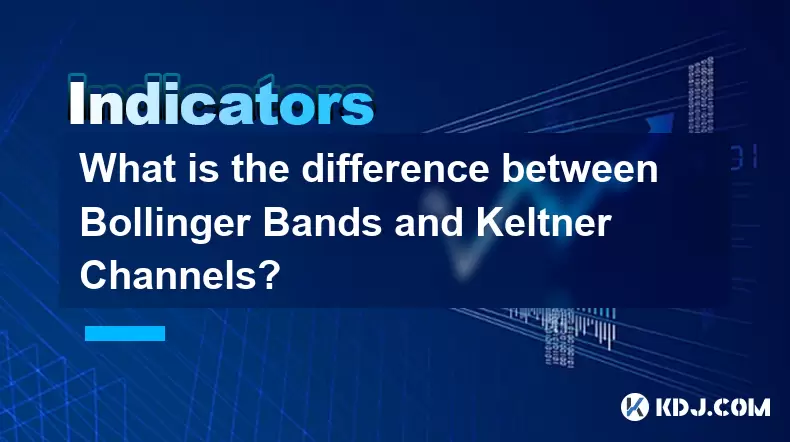
What is the difference between Bollinger Bands and Keltner Channels?
Jul 30,2025 at 11:30pm
Understanding Bollinger Bands and Their Core ComponentsBollinger Bands are a widely used technical analysis tool developed by John Bollinger in the 19...
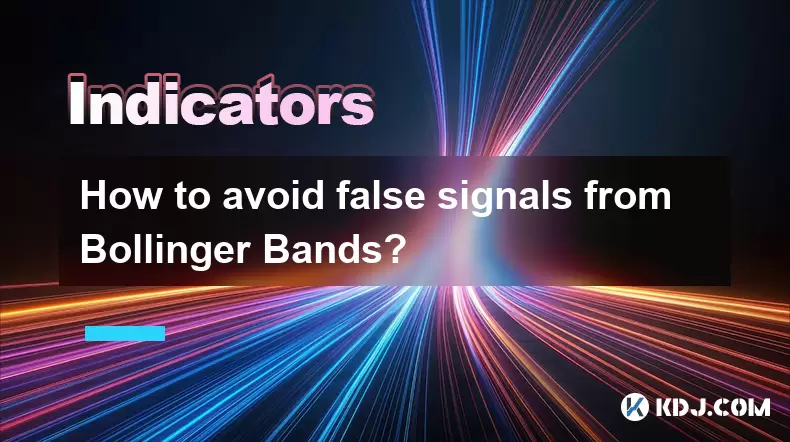
How to avoid false signals from Bollinger Bands?
Jul 30,2025 at 11:42pm
Understanding Bollinger Bands and Their Core ComponentsBollinger Bands are a widely used technical analysis tool developed by John Bollinger in the 19...
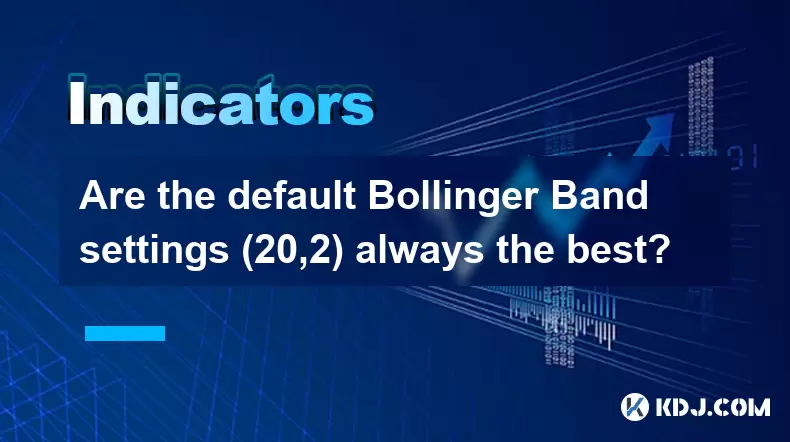
Are the default Bollinger Band settings (20,2) always the best?
Jul 30,2025 at 11:36pm
Understanding the Standard Bollinger Band ConfigurationThe default Bollinger Band settings of (20,2) are widely used across the cryptocurrency trading...
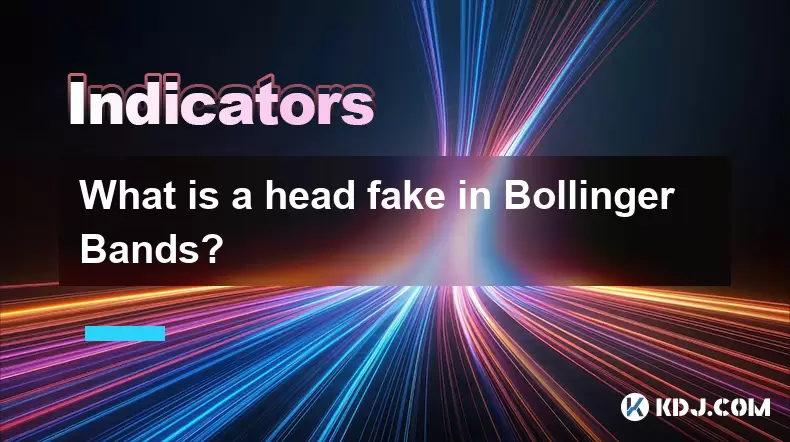
What is a head fake in Bollinger Bands?
Jul 30,2025 at 09:44pm
Understanding Bollinger Bands and Their StructureBollinger Bands are a widely used technical analysis tool developed by John Bollinger in the 1980s. T...

Do Bollinger Bands work for all cryptocurrencies?
Jul 30,2025 at 09:30pm
Understanding Bollinger Bands in Cryptocurrency TradingBollinger Bands are a widely used technical analysis tool developed by John Bollinger in the 19...
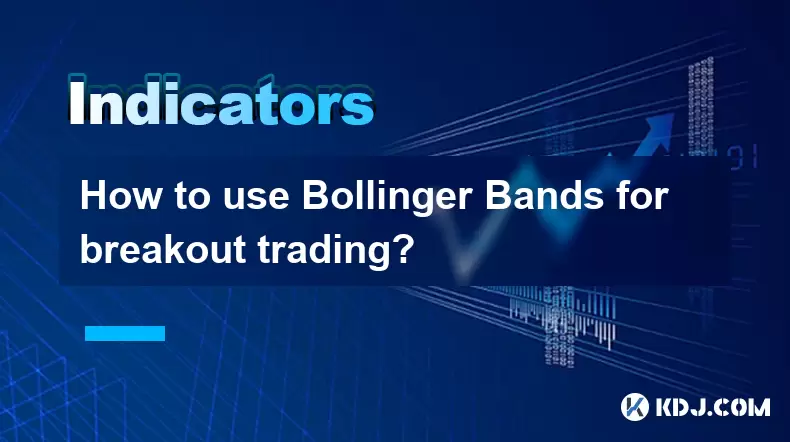
How to use Bollinger Bands for breakout trading?
Jul 30,2025 at 10:27pm
Understanding Bollinger Bands and Their ComponentsBollinger Bands are a widely used technical analysis tool developed by John Bollinger in the 1980s. ...

What is the difference between Bollinger Bands and Keltner Channels?
Jul 30,2025 at 11:30pm
Understanding Bollinger Bands and Their Core ComponentsBollinger Bands are a widely used technical analysis tool developed by John Bollinger in the 19...

How to avoid false signals from Bollinger Bands?
Jul 30,2025 at 11:42pm
Understanding Bollinger Bands and Their Core ComponentsBollinger Bands are a widely used technical analysis tool developed by John Bollinger in the 19...

Are the default Bollinger Band settings (20,2) always the best?
Jul 30,2025 at 11:36pm
Understanding the Standard Bollinger Band ConfigurationThe default Bollinger Band settings of (20,2) are widely used across the cryptocurrency trading...

What is a head fake in Bollinger Bands?
Jul 30,2025 at 09:44pm
Understanding Bollinger Bands and Their StructureBollinger Bands are a widely used technical analysis tool developed by John Bollinger in the 1980s. T...

Do Bollinger Bands work for all cryptocurrencies?
Jul 30,2025 at 09:30pm
Understanding Bollinger Bands in Cryptocurrency TradingBollinger Bands are a widely used technical analysis tool developed by John Bollinger in the 19...

How to use Bollinger Bands for breakout trading?
Jul 30,2025 at 10:27pm
Understanding Bollinger Bands and Their ComponentsBollinger Bands are a widely used technical analysis tool developed by John Bollinger in the 1980s. ...
See all articles

























































































